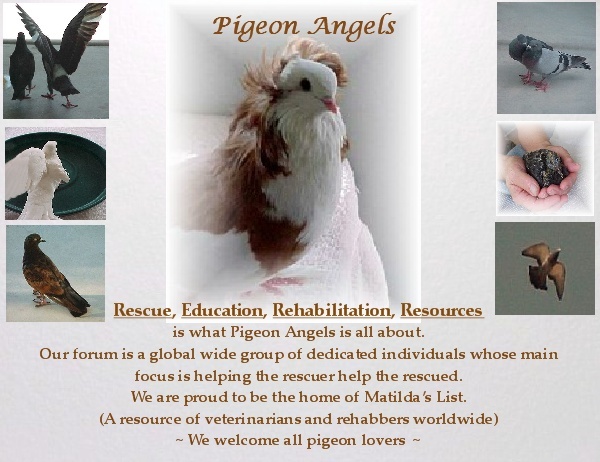Basic Steps to Saving the Life of a Pigeon or Dove
--------------------------------------------------------------------------------
It is vital to stabilize an ill or injured pigeon or dove as soon as possible after rescue.
Three basic steps should be followed.
HEAT, ISOLATION & HYDRATIONHEAT:A bird must be warmed gradually to a normal body temperature and be responsive (able to swallow). It is not unusual for a baby bird presented for rehabilitation to be very cold. (If a bird is unresponsive, please seek the assistance of an experienced rehabber or avian vet immediately.)
If head trauma is suspected, do not place them on heat.
Give the bird a quick, superficial examination. Unless there is a critical situation, e.g., (severe bleeding) all birds should be covered and placed on a heat source* (see below) for at least 20-30 minutes to bring the body temperature back to normal.
ISOLATION:Allow the bird to stabilize in a quite, dark, warm area.
While the bird is warming, take the opportunity to prepare any other items you may need to care for the bird, e.g., International Rehydrating Solution (recipe noted below)
A 'COLD' BIRD SHOULD NEVER BE GIVEN FLUID OR FOOD, PERIOD!! HYDRATION:Fluids should be given after, and ONLY AFTER, the bird has been warmed, examined for any injuries & a determination is made as to the severity of his dehydration.
All fluids should be warmed or at room temperature!
Description and degrees, of hydrated and dehydrated birds
A well hydrated bird will be very alert, have elastic skin, bright eyes, moist, plump membrane inside the mouth and well formed moist droppings.
A moderately dehydrated bird will be less than fully alert, have dry, flaky skin, dull eyes, non-formed droppings and have a sticky membrane in the mouth.
A severely dehydrated bird will be lethargic or unconscious, the skin will 'tent' when slightly pinched, have sunken eyes, dry or absent droppings and have dry membrane in the mouth.
Depending on the cause and degree of dehydration, reversing this condition can take up to 24 hours. If the bird is alert, he may be rehydrated by mouth, using an eye dropper and putting drops along his beak every few minutes, making sure the fluids are room temperature or warmed slightly. Initially, a rehydrating solution should be administered. Plain water should not be given unless nothing else is available.
If the bird is not swallowing on his own or fully alert, he must be given fluids under the skin (sub-Q method).
WARNING!! This procedure should only be performed by an experienced rehabber or vet.
Please follow these simple, basic, yet most important steps.
The cells of the body simply don't work properly when dehydrated. Absolutely no digestive processes can take place if the gut CAN'T work. Absorption will not take place, food sits in the gut, undigested, and will eventually kill the bird.
* Heat source suggestions:
Towel lined heating pad, set on low
Towel lined hot water bottle
Low wattage lamp, directing the light into the cage.
* Emergency heat source substitute:
Fill an old sock about 2/3 full of rice. Microwave the sock for a few seconds. Making sure it isn't too hot, place it around the bird.
* International Rehydrating Solution:
To a cup of warm water add a pinch of salt & sugar, mix well. Use this solution to rehydrate by mouth.
* Emergency rehydrating substitute:
Pedialyte, unflavored.
By following these basic steps you have done your best to stabilize your little feathered patient until further assistance is available.
Cindy


